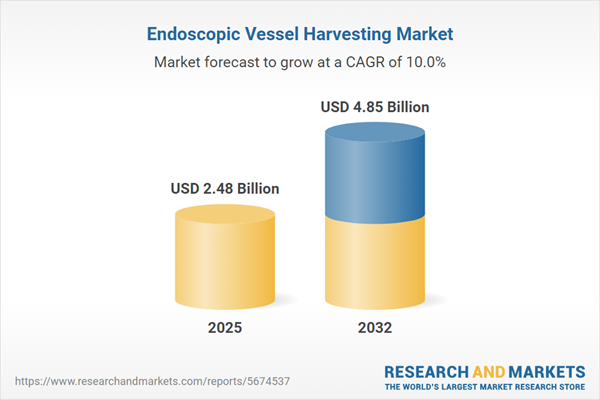Speak directly to the analyst to clarify any post sales queries you may have.
Senior healthcare leaders face a rapidly shifting landscape in the endoscopic vessel harvesting market as advancements in technology and regulatory requirements reshape procurement, clinical governance, and operational models. Aligning these strategies is essential for maintaining competitiveness and compliance in the evolving cardiovascular medical field.
Market Snapshot: Endoscopic Vessel Harvesting Market Size and Dynamics
The endoscopic vessel harvesting market is charting a steady growth trajectory, supported by increased demand for minimally invasive cardiovascular procedures across global healthcare systems. Hospitals and ambulatory surgical centers are streamlining surgical workflows, shortening patient recovery times, and ensuring procedure consistency. Manufacturers respond with advanced vessel harvesting solutions designed to align with current compliance standards, enhancing clinical efficacy in diverse settings. Investments in next-generation devices enable providers to improve care quality and maintain operational continuity, reflecting a trend toward innovative, reliable, and value-focused solutions in the business-to-business segment.
Scope & Segmentation
- Product Category: Hospitals choose from adapters, cannulas, insufflation tubing, and other components, available in both single-use and reusable formats. This variety enables improvements in infection control, patient safety, cost management, and sustainability.
- Technology: Automated vessel harvesting platforms drive procedural efficiency and reduce variability, supporting standardization for consistent outcomes. Manual systems offer flexibility, addressing the needs of unique anatomical considerations and complex cases.
- End User: Hospitals, ambulatory surgical centers, and leading university-affiliated networks leverage staff training and strict clinical protocol adherence to ensure strong governance and effective risk management.
- Application: Devices facilitate procedures spanning coronary artery bypass surgery, limb reconstruction, and dialysis access creation. Multidisciplinary teams benefit from versatile systems that accommodate wide-ranging clinical needs and align with established workflows.
- Regional Coverage: North America and Europe remain frontrunners in adopting new technologies due to mature infrastructure and integration capabilities. East and Southeast Asia display robust market growth, fueled by collaborative care networks and expanding infrastructure. The Middle East and Africa continue to advance through targeted investments and tailored supply strategies, broadening market penetration.
- Key Companies: Medtronic plc, Getinge AB, Terumo Corporation, B. Braun Melsungen AG, LivaNova PLC, CryoLife Inc., Teleflex Incorporated, Johnson & Johnson, Abbott Laboratories, and Stryker Corporation deliver global operational support and comply with rigorous regulatory standards for vessel harvesting technologies.
Key Takeaways: Executive Insights for Strategic Direction
- Automated solutions for endoscopic vessel harvesting equip clinical teams to manage higher case volumes efficiently, adapting to variable resource availability in cost-conscious settings.
- Greater adoption of single-use kits aligns with infection prevention priorities and supports organizational sustainability goals, standardizing quality across healthcare systems.
- Digital analytics tools empower leadership to track workflow performance, identify opportunities for improvement, and circulate best practices throughout dispersed teams.
- Collaboration between healthcare providers, manufacturers, and technology partners enhances preparedness for product updates and regulatory changes, driving market responsiveness.
- Procurement flexibility and diversified supply strategies support agile adaptation to evolving compliance requirements and reimbursement systems, aiding in business continuity.
- Regional intelligence facilitates targeted market entry and sharper competitive positioning, allowing enterprises to adapt to local market variations.
Tariff Impact: Strategic Adjustments in Supply Chains
Recent U.S. tariff changes are prompting manufacturers to relocate production closer to critical hospital markets, strengthening supply chain resilience. This shift fosters proactive collaboration between device providers and healthcare organizations, while advanced data analytics support accurate demand forecasting and safeguard uninterrupted product availability amid market evolution.
Methodology & Data Sources
This analysis leverages comprehensive clinical literature reviews, regulatory and patent databases, and direct insights from interviews with international healthcare experts. Additional survey data from major healthcare organizations enriches the understanding of innovation and ongoing process improvements within vessel harvesting workflows.
Why This Report Matters
- Delivers granular segmentation and benchmarking data, enabling executives to refine strategy, streamline processes, and drive operational outcomes.
- Equips procurement and clinical managers with actionable insights for compliance management and seamless integration of advanced vessel harvesting technologies.
- Highlights opportunities for innovation and stakeholder collaboration to help organizations remain responsive to market developments and regulatory shifts.
Conclusion
Adopting advanced technology and strengthening procurement agility prepare healthcare organizations to maintain clinical integrity and operational resilience as the endoscopic vessel harvesting market undergoes transformation.
Additional Product Information:
- Purchase of this report includes 1 year online access with quarterly updates.
- This report can be updated on request. Please contact our Customer Experience team using the Ask a Question widget on our website.
Table of Contents
3. Executive Summary
4. Market Overview
7. Cumulative Impact of Artificial Intelligence 2025
Companies Mentioned
The companies profiled in this Endoscopic Vessel Harvesting market report include:- Medtronic plc
- Getinge AB
- Terumo Corporation
- B. Braun Melsungen AG
- LivaNova PLC
- CryoLife, Inc.
- Teleflex Incorporated
- Johnson & Johnson
- Abbott Laboratories
- Stryker Corporation
Table Information
| Report Attribute | Details |
|---|---|
| No. of Pages | 198 |
| Published | October 2025 |
| Forecast Period | 2025 - 2032 |
| Estimated Market Value ( USD | $ 2.48 Billion |
| Forecasted Market Value ( USD | $ 4.85 Billion |
| Compound Annual Growth Rate | 10.0% |
| Regions Covered | Global |
| No. of Companies Mentioned | 11 |









